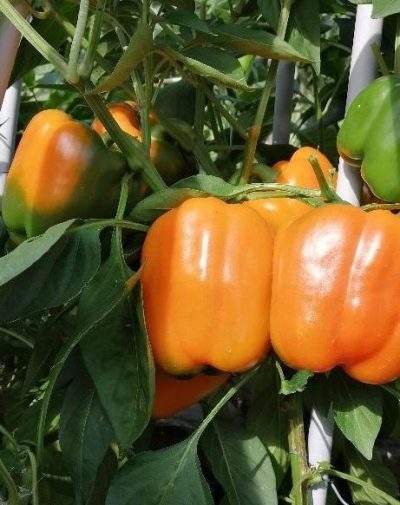
- Authors: Blokin-Mechtalin V.I.
- Year of approval: 2019
- Growth type: vigorous
- Fruit shape: cuboid
- Fruit weight, g: 200-250
- Fruit color: green in technical ripeness, dark orange in biological ripeness
- Ripening terms: early
- Ripening month: July August September
- Fruit size, cm: diameter 9-10
- Average yield: 12.5 kg / sq.m
Bell peppers do not have a variety of colors. This sweet variety of vegetables is distinguished by yellow, red, purple, and even green fruits. But the recently bred Allar F1 hybrid impresses with its bright sunny color. An orange vegetable not only looks spectacular on a plate in various dishes, it is also healthy, as it is full of sugars.
Breeding history
Pepper Allar F1 is one of the latest achievements of domestic breeders from the partner agrofirm. The author of culture and originator is a well-known specialist and head of the firm V.I.Blokin-Mechtalin. The newest hybrid variety was entered in the State Register of the Russian Federation in 2019 and approved for cultivation practically throughout the entire Russian territory.
Description of the variety
The hybrid variety Allar F1 is a fleshy, thick-walled bell pepper suitable for cultivation in greenhouses and on open ground. A productive and early maturing crop, it perfectly adapts to various weather changes, and also brings fairly high and early yields. At the same time, it is distinguished by a long fruiting period, which lasts until autumn days.
Characteristics of the appearance of plants and fruits
Allar plant is low, half-stem type. It grows no more than half a meter. The crown of the bush is semi-spreading. The green foliage is medium in size, oval and slightly wrinkled.
The location of the peppers on the bush is drooping. The fruits are beautiful, cuboid, and look massive. With technical ripeness, they are green in color, and with the onset of full biological formation, they turn into bright orange fruits. The walls of the fruit are rather thick, almost one centimeter long. The weight of one pepper is on average 200-250 grams, the diameter is 9-10 cm. Each of them has 4 chambers inside. 6-8 cuboid fruits are formed on the bush.
Purpose and taste
Allar is not only beautiful, but also very tasty pepper. Its sweet taste does not have the slightest hint of bitterness. Of course, it is most useful to eat it fresh: fresh salads, snacks, and it is also good in hot dishes of home cooking and canning, for preparations.
Ripening terms
An early ripe hybrid variety of Allar pepper is capable of fully ripening in 90-100 days, if you count from germination to the beginning of fruiting, which occurs in July-September.
Yield
On average, 12.5 kilograms of orange and sweet fruits can be obtained from one square meter of planting.
Growing regions
Plants of the considered bell pepper feel great not only in warm, but also in temperate climates, as well as in cooler Siberian, Ural regions, in Altai.

To get a large and tasty harvest of pepper, you need to take care of the seedlings in advance. When growing pepper seedlings, you need to correctly determine the sowing time, pre-sowing seed treatment, prepare the necessary container and soil.
Growing and caring
Pepper Allar the originator recommends cultivating in seedlings. To do this, the seeds should be pre-germinated, the seedlings should be grown at an indoor temperature of +25 degrees. So that the growth of the pepper does not slow down after the pick, it is better to sow the seed in individual containers. Seedlings can be transplanted to a permanent place when they reach the age of 60-70 days.
The pepper is planted according to the scheme - up to 6 plants per 1 m2. When planting grown seedlings in the ground under a bush, the ground does not need to be tamped.
Water the Allar pepper when the soil dries out to a depth of 1 cm. The multiplicity is up to 2-3 times a week. Moisturize plants in the morning or evening hours. And watering should be combined with loosening. Mulching the soil is effective, for this you can use hay, compost, straw.
The formation of the bush is as follows: after the 1st fork on the plant, the leaves and all lateral processes are removed.
Fertilization is necessary for a crop per season in the amount of 3 times with nitrogen compositions, as well as phosphorus-potassium additives.

To harvest a tasty and rich harvest of pepper, you need to comply with all the conditions of agricultural technology, and proper care begins with planting plants. Before planting pepper in open ground, it should be prepared. It is also important to take care of the seedlings and planting space in advance.




For good growth of pepper bushes and active fruiting, you need to regularly apply mineral and organic fertilizing to the soil. It is necessary not only to choose the right formulations, but also to use them at the right stage in the development of culture. The frequency of top dressing is always individual. It depends directly on the composition of the land on your site. The poorer the soil composition, the more often you will need to feed the pepper.
Disease and pest resistance
Allar F1 hybrid pepper has a strong immune system. Resistant to viral pathogens, not exposed to TMV infection. From harmful insects, bushes are attacked by ticks, aphids, slugs. For processing, you can use ash infusion, as well as garlic with the addition of lum and dandelion, preparations containing metaldehyde.

Pepper is one of the most common vegetables in home gardens. This culture is quite stable and unpretentious. However, under certain conditions, this plant can suffer from infections and harmful insects.Before treating peppers for diseases or pests, you need to find out the cause of the problem, otherwise the treatment may be ineffective.





















































































